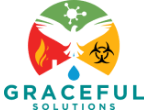FAQs
Mold or water damage in your home can be overwhelming. If you have questions, we have answers. Here are a few FAQ to help you understand our mold mitigation and damage repair services.
Need more answers?
Get in touch with us. Graceful Solutions
is here to help you fully restore your property.
Mold Mitigation FAQs
Is mold dangerous to my family or pets?
Yes—certain molds release airborne spores that can trigger:
- Asthma
- Allergies
- Headaches
- Eye irritation
- Respiratory issues
Children, seniors, and pets are especially sensitive. Mold mitigation is essential for a safe home.
What services does Graceful Restorations provide?
Graceful Restorations specializes in mold mitigation, water damage restoration, fire damage repair, smoke cleanup, and structural restoration for homes and businesses in Martinsburg, Charles Town, Ranson, and surrounding areas in West Virginia.
Our team handles everything from emergency cleanups to full repairs so your property is safe, clean, and restored properly.
What areas do you service?
We proudly serve all of:
- Martinsburg, WV
- Charles Town, WV
- Ranson, WV
- Berkeley County
- Jefferson County
- Surrounding West Virginia regions
If you’re unsure whether we service your area, just give us a call.
Do you offer emergency or same-day restoration services?
Yes. We provide rapid response for urgent situations such as flooding, storm damage, burst pipes, and mold dangers.
In most cases within Martinsburg or Charles Town, we can be on-site the same day to begin assessment and containment.
Do you remove black mold?
Yes. We safely handle Stachybotrys chartarum (black mold) and other toxic molds. We use containment methods, air filtration, and proper mitigation techniques to restore a healthy indoor environment.
How quickly should I respond to water damage?
Immediately. Water damage spreads fast—within hours it can lead to:
- Mold growth
- Structural weakening
- Warped flooring
- Damaged drywall
The sooner we begin water mitigation, the more you can save in repair costs.
Do you work with homeowner’s insurance for water or fire damage?
Yes. We help homeowners document the damage, provide detailed reports, and communicate directly with insurance adjusters.
Our goal is to make your claim easier, not more stressful.
What is the difference between mold mitigation and mold remediation?
- Mold mitigation stops mold from spreading, removes contamination, and restores affected areas safely.
- Mold remediation is a larger-scale process often required when mold has spread extensively.
We specialize in mold mitigation, which eliminates mold sources, restores air quality, and protects your home long-term.
How do I know if I have mold in my home?
Common signs include:
- Musty odors
- Dark or fuzzy spots on walls or ceilings
- Respiratory irritation
- Allergy-like symptoms
- Water stains
- Visible moisture or dampness
If you suspect mold, contact us for an assessment. Early detection prevents bigger problems.
How long does mold mitigation take?
Most mold projects take between 1–3 days, depending on size and severity.
Larger or more complex cases may take longer, especially if materials need replacement.
What causes water damage in homes?
Common causes include:
- Burst pipes
- Roof leaks
- Storm water intrusion
- Faulty plumbing
- Water heater failures
- Overflowing appliances
We identify the source, stop the problem, and restore the damaged areas.
How long does water restoration take?
Most water cleanup and drying takes 2–4 days, followed by repairs depending on damage severity.
We provide a full breakdown once we assess your property.
Do you handle fire and smoke damage cleanup?
Yes. We restore homes after:
- Kitchen fires
- Electrical fires
- Small household fires
- Smoke odor contamination
- Soot damage
We clean, deodorize, repair, and restore affected areas.
Can you remove smoke odor from walls and furniture?
Yes. We use advanced deodorization and HEPA filtration to eliminate smoke odor from:
- Drywall
- Carpet
- Furniture
- HVAC systems
- Ceilings
- Insulation (case-by-case)
We ensure your home smells clean again—not just temporarily masked.
What should I do immediately after a fire?
After ensuring safety, contact a professional restoration team. We can help you:
- Document damage
- Secure the home
- Prevent further deterioration
- Begin cleanup and repair
Fire damage worsens over time, so fast action is important.
Do you offer structural repairs after damage?
Yes. We don’t just clean—we restore and rebuild.
This includes:
- Drywall repairs
- Flooring replacement
- Structural reinforcements
- Subfloor repairs
- Repainting
- Trim and carpentry
We make your home look as good—or better—than before.
Will the restoration process disrupt my home?
We work efficiently and respectfully, using containment methods and equipment to minimize disruption. For most jobs, you can remain in your home safely during work.
How much does restoration cost?
Costs depend on:
- Size of the affected area
- Type of damage (water, mold, fire)
- Severity and spread
- Materials needed
We provide transparent, upfront estimates before any work begins. No surprises.
Why should I choose Graceful Restorations?
Homeowners choose us because we offer:
- Local, family-run service
- Modern drying equipment
- Transparent communication
- Fast response times
- High-quality workmanship
- Honest assessments—never upselling
We restore your home with precision, care, and integrity.
How do I schedule an appointment?
You can contact us through:
- The website form
- Phone
We respond quickly and can often schedule same-day assessments in Martinsburg, Charles Town, or Ranson.
Water Damage FAQs
What are the different types of water damage?
The IICRC (Institute of Inspection, Cleaning and Restoration Certification) breaks down water damage into these 4 classes:
- Class 1: minor water intrusion that impacts a part of a room and has minimal absorption.
- Class 2: larger areas impacted, some absorption into the flooring and walls.
- Class 3: water saturation in multiple areas of floor, ceilings, walls, and insulation.
- Class 4: full saturation that requires professional extraction and drying.
What are the types of water that can damage a home?
Standing or flooding water in your home can be classified into these categories:
- Clean water: sanitary water that may come from a leak or burst pipe.
- Black water: unsanitary water or sewage that poses a risk to your health.
- Gray water: a mix of clean and black water such as toilet overflow.
- Storm water: excessive rain or river water that flows into your home during a storm.
When should I call a water damage specialist?
After any amount of flooding or storm damage, it’s smart to bring in a specialist. You should also call a professional if you notice leaks, sagging ceilings, or warped floorboards — these can be signs of long-term water damage.

